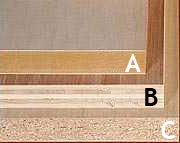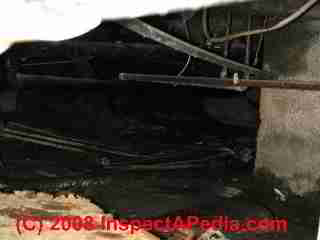Appropriate Technology for Drywood Termite Control
Drywood Termite Control
By Bill Mashek
(From IPM Practitioner, February, 1998) This article, written by a California PCO, describes his experiences with least-toxic termite control over the past 15 years in Northern California.
Drywood termites, Incisitermes minor, are an important economic pest in California. They are responsible for millions of dollars worth of damage to homes and business annually. Drywood termites are at best difficult to detect. Their colonies exist deep inside wood, and except during periods when they swarm, or during renovation work to infested areas, they are rarely seen. The best determination of an infestation is finding their hexagonal-shaped fecal pellets, which are about the size of coarse salt (Potter 1997a).
Drywood termite inspections require a highly experienced inspector often with the use of specialized tools. One company uses specially trained dogs to detect infestations. Treatment options include categories of "whole house" or localized "spot treatments." Approximately 72% of drywood treatments are localized (Potter 1997b). There is very little empirical data on the efficacy of varying types of treatments, except for fumigation.
Villa Termiti, a 20 ft by 20 ft (6.1 m by 6.1 m) wood frame structure with stucco exterior and non-functioning plumbing and electrical wires was built at the University of California to test a variety of drywood termite treatments – heat, freezing, microwaves, Electrogun, and fumigation. Natural and artificially infested boards were built into the structure. All methods averaged at least 90% termite mortality (Lewis and Haverty 1996). [For a detailed summary, see Quarles 1996].
Northwest Termite, Inc. is an integrated pest management company. We do our best to use less toxic and still the most effective methods available. However, we have to be pragmatic. There are no true alternatives to fumigation for treating a "whole structure" effectively and economically. Some may argue that heat fumigation is a "whole structure" treatment. Though highly efficacious as a localized treatment, heat has many complications in both preparation and treatment for a whole house. There are cases where we would recommend a fumigation as the best possible treatment. This happens about 10% of the time.
Inspection and Treatment
We at
Northwest Termite begin our treatment process with a thorough inspection to determine the extent of the infestation. For treatment, we have invested in a large microwave system and an Electrogun. These methods, combined with drill and injection, are both effective and relatively non-intrusive.
Once we have an idea of the infestation, we can begin our treatment with the Electrogun as a diagnostic tool. This can give us a better understanding of the extent of the infestation. The Electrogun works on the principle of "high voltage penetration." Wood, being a natural dielectric, will create resistance until a void or termite gallery is encountered. There is then a surge of current through this path of least resistance. Under optimum conditions, where the "drill and pin" technique is used, the Electrogun has proved to be 98% effective against drywood termites (see Quarles 1996; Lewis and Haverty 1996). Though sheet rock walls can be "scanned" with moderate efficacy, the Electrogun works best on exposed wood, as in an attic, eaves or subarea.
The microwave process seems to work best over covered walls, excluding thin paneling. The microwave process has been used in the forest products industry for years, but only recently has it been applied to drywood termite treatment. The process works by spinning water molecules, causing heat to be produced by friction. Anything containing water can be heated with microwaves. In treating for termites, wood may only have a moisture content of 4%, whereas termites can contain over 70% water. Consequently, termites die by boiling to death. Microwaves have limitations as well. Minor damage can occur to structures if the operator is inexperienced. Also, it lacks sufficient portability for treating eaves and subareas. Both Electrogun and Microwave should only be used by experienced, trained technicians. As with any tool, its effectiveness is directly related to the experience of the operator. The technicians at
Northwest undergo continuous training. We follow all physical treatments with drill and injection of wood with either borates or the live fungus Metarhizium anisopliae (Bioblast) If we find live termites in the wood, we inject BioBlast into the galleries. The fungus will remain active up to 30 days. This method is highly effective, but short-lived (Quarles, 1997). On most wood, we inject borates to give long-term residual protection. We always apply topical applications of borate to exposed wood in infested areas for long-term prevention.
Many infestations can be avoided with proper protections. Many of these protections should be part of home maintenance, which includes keeping your home well-sealed and in a water-tight condition. Exposed beams should be protected from the elements. Drywood termites will typically infest the most exposed areas of your home, especially where incipient decay may be present. The idea is to keep your home a place that is not "inviting" to termites. Topical applications of borate offer long-term prevention against many wood-destroying organisms if applied to enclosed areas on unfinished surfaces.
Northwest Termite has a pretreatment program for people building their homes. We treat all exposed wood with borates during the framing process of the home.
I would like to conclude by stating that we are always 100% effective, however we are not. Sometimes on difficult jobs we may have to re-treat an infested area several times. Integrated Pest Management requires more work and experience on the part of the technician and inspector. It also allows homeowners to take a more proactive approach to protecting their homes.

 The most important determining factor for kitchen cabinet quality will be the material. Kitchen cabinets are most commonly built using plywood (A), MDF (B), or particle board (C). A plywood cabinet will almost always be of the highest quality when compared to MDF (medium density fiberboard) or particle board. It is very rare to find solid wood cabinets, and if you do find them they are not as good as they sound, they warp easily and crack easily. MDF or particle board cabinets can also warp easily but they absorb moisture very easily which results in swelling and odor absorption. Another important determining factor in selecting a good cabinet will be the finish. Any wood cabinet will usually have a veneer covering that is used to make the cabinet appear to be made of solid wood.
The most important determining factor for kitchen cabinet quality will be the material. Kitchen cabinets are most commonly built using plywood (A), MDF (B), or particle board (C). A plywood cabinet will almost always be of the highest quality when compared to MDF (medium density fiberboard) or particle board. It is very rare to find solid wood cabinets, and if you do find them they are not as good as they sound, they warp easily and crack easily. MDF or particle board cabinets can also warp easily but they absorb moisture very easily which results in swelling and odor absorption. Another important determining factor in selecting a good cabinet will be the finish. Any wood cabinet will usually have a veneer covering that is used to make the cabinet appear to be made of solid wood.  This species is restricted to the West, ranging from British Columbia to Mexico.
This species is restricted to the West, ranging from British Columbia to Mexico. These insects live in wood which has a relatively low moisture content (12% or less), in the Western United States, Northwestern Mexico, and Florida. They are swarmers 7/16" to 1/2 " long including wings. Their heads and pronotums are orange brown, abdomens are dark brown, and wing membranes and hardened veins are blackened. They have Antenna with 10-11 segments. They are not hairy, their tibia exhibit no spines along their length and they have no pad between their claws.
These insects live in wood which has a relatively low moisture content (12% or less), in the Western United States, Northwestern Mexico, and Florida. They are swarmers 7/16" to 1/2 " long including wings. Their heads and pronotums are orange brown, abdomens are dark brown, and wing membranes and hardened veins are blackened. They have Antenna with 10-11 segments. They are not hairy, their tibia exhibit no spines along their length and they have no pad between their claws. As their name implies, dampwood termites locate their colonies in damp, sometimes decaying wood.
As their name implies, dampwood termites locate their colonies in damp, sometimes decaying wood.
 Anobiids Beetles are the most commonly encountered of the powderpost beetles. They are also called Deathwatch beetles because of a tapping sound they make when mating. Heard in the quiet of the night by people sitting with an ill person, this tapping was believed to indicate that death was near.
Anobiids Beetles are the most commonly encountered of the powderpost beetles. They are also called Deathwatch beetles because of a tapping sound they make when mating. Heard in the quiet of the night by people sitting with an ill person, this tapping was believed to indicate that death was near. Wood Decay fungus (poria incrassata)
Wood Decay fungus (poria incrassata) Several species of carpenter ants, Camponotus spp., are capable of damaging wood in buildings and other structures. Carpenter ants cause problems mainly in mountainous areas and in forested rural areas along the central and northern coastlines of California; they may also invade buildings in urban locations.
Several species of carpenter ants, Camponotus spp., are capable of damaging wood in buildings and other structures. Carpenter ants cause problems mainly in mountainous areas and in forested rural areas along the central and northern coastlines of California; they may also invade buildings in urban locations. Queens typically are the largest ants in the colony. After selecting a nest site, a queen will begin laying eggs and caring for her brood. The first workers that develop assume brood care, leaving the queen to simply lay eggs. Ant colonies can have single or multiple queens. The number of queens in multiple queen colonies varies by species, ranging from a few queens to nearly half the population in a colony. Depending on the species, queens may live from months to years.
Queens typically are the largest ants in the colony. After selecting a nest site, a queen will begin laying eggs and caring for her brood. The first workers that develop assume brood care, leaving the queen to simply lay eggs. Ant colonies can have single or multiple queens. The number of queens in multiple queen colonies varies by species, ranging from a few queens to nearly half the population in a colony. Depending on the species, queens may live from months to years. Males serve one purpose: to mate with the queen. Males typically die soon after mating, and are normally alive solely during the colony's reproductive stage.
Males serve one purpose: to mate with the queen. Males typically die soon after mating, and are normally alive solely during the colony's reproductive stage.


